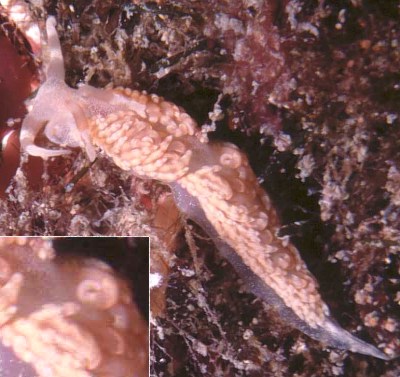
Pruvotfolia pselliotes
(Labbe, 1923)
Order: NUDIBRANCHIA
Family: Glaucidae
DISTRIBUTION
Known from the Atlantic coast of France, Mediterranean coast of Spain. Reported here from Turkey & Senegal.
PHOTO
Istanbul, Turkey, Divesite: Yassiada, Depth: 27m
Size: 5cm. 30 September 2001. Photo: Baki Yokes
Pruvotfolia pselliotes was initially described under the name of Facelina pselliotes. It has a very distinctive arrangement of modified cerata associated with the reproductive apparatus which Tardy felt justified the creation of a new genus for it in 1969. Its body is translucent and tinted with brown on the oral tentacles, rhinophores and back. There are numerous opaque white spots on the body. The oral tentacles are long, stout at the base, tapering to fine points. They have yellow-ochre pigment at the tips and in a band midway along them. The rhinophores have similar pigmentation and have about thirty fine lamellae. The cerata have two yellow-ochre bands and a yellow-ochre tip. They are numerous and range in size from very small ones at the sides to long muscular ones in the centre of the back which are normally coiled inwards but can be flexed vigorously when the animal is disturbed. These long ones can easily be shed (autotomised) and regrow quite quickly. Other species with similar cerata are Caloria elegans and Moridilla brocki.
Tardy found numerous animals intertidally at a few sites on the French Atlantic coast where they were feeding on a variety of hydroids. The spawn coil as laid in his aquarium was a fine spiral. Gosliner (1987) has proposed that Facelina faurei Barnard, 1927 described from South Africa, is an earlier name but colour differences suggest further comparative study is required before this can be determined.
References:
• Gosliner, T.E. (1987) The Nudibranchs of Southern Africa. Sea Challengers & Jeff Hamann: Monterey.
• Tardy, J. P. (1969). Un nouveau genre de nudibranche méconnu des côtes Atlantique et de la Manche: Pruvotfolia (nov. g.) pselliotes, (Labbe) 1923. Vie et Milieu (A), Biologie Marine, 20(2): 327-346, 6 pls.
• Ortea, J. A., & Urgorri, V. (1981). Runcina ferruginea Kress 1977, et Pruvotfolia pselliotes (Labbe, 1923) dans les eaux Ibériques. Vie et Milieu, 31(2): 149-151.
Picton, B.E., 2001 (November 1) Pruvotfolia pselliotes (Labbe, 1923) . [In] Sea Slug Forum. Australian Museum, Sydney. Available from http://www.seaslugforum.net/find/pruvpsel
Related messages
Pruvotfolia pselliotes from the Atlantic coast of France
April 22, 2008
From: Sandra Sohier
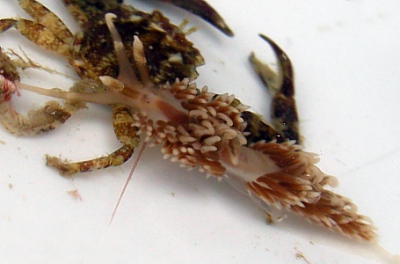
Hello,
This is some pictures of Facelina, but I don't know if it's F. coronata or F. bostoniensis. Can you help me for identification?
Locality: St-Malo, 15 m, France, Atlantic - Manche, 16 September 2007, on a fish trap. Length: 3 à 4 cm. Photographer: Sandra Sohier.
Thanks a lot
Sandra Sohier
sandra.sohier@cmas.fr
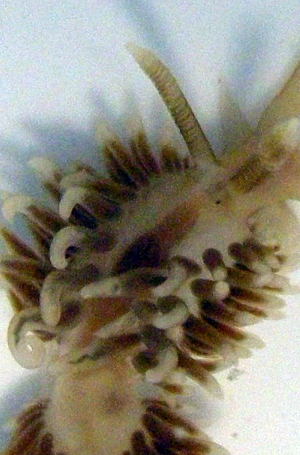
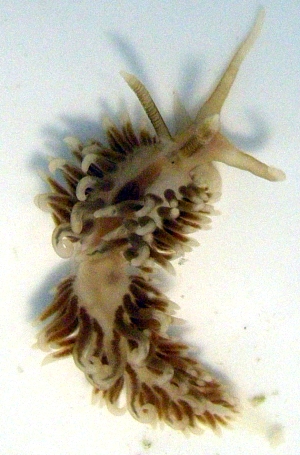
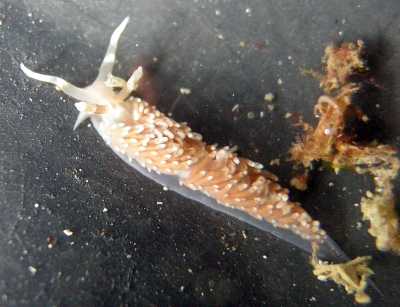
Dear Sandra,
This is not a species of Facelina but is the interesting species Pruvotfolia pselliotes which was first described from the Atlantic coast of France and has since been found in the Mediterrean as well. Have a look at the species' Fact Sheet and attached messages for more information.
I have included a close-up of one of your photos which shows a couple of distinctive features. One is the fine leaflets on the rhinophores and the other is how some of the inner cerata are much longer than the rest and lie curled up. However if the animal is disturbed, these cerata immediately unfold and wave around apparently to disturb the potential prey. Another species that does this is Moridilla brockii, which is featured in another of today's messages [#20818].
Best wishes,
Bill Rudman
Pruvotfolia pselliotes from Malta
November 21, 2006
From: Constantine Mifsud
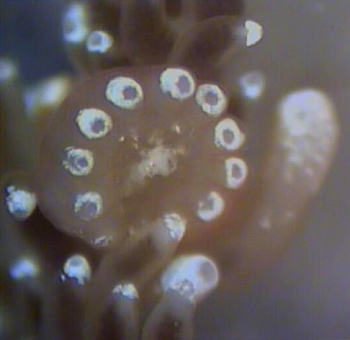
Bill,
Here are a few images of Pruvotfolia pselliotes found from a dredging.
I include a close up of the "showy" genitalia of this species. The species was determined for me by Dr. Juan Lucas Cervera Currado.
Locality: Off Fomm ir-Rih Bay, 160 m, Malta, Mediterranean, October 2006, muddy substrate . Length: 15 mm. Photographer: C. Mifsud.
Constantine Mifsud
kejdon@orbit.net.mt
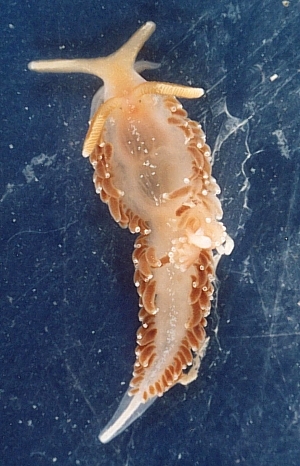
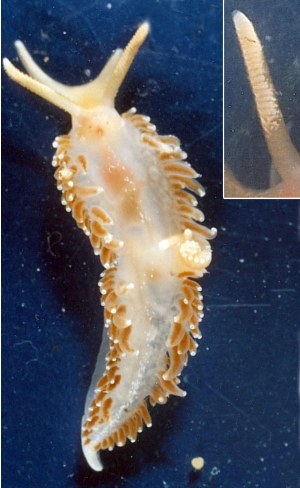
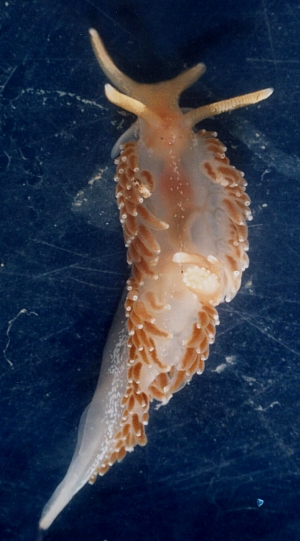
Dear Con,
Thanks for these interesting photos. They well illustrate the distinctive arrangement of modified cerata associated with the reproductive apparatus which Tardy felt justified the creation of the genus Pruvotfolia.
Best wishes,
Bill Rudman
Pruvotfolia pselliotes from Senegal [1}
August 9, 2003
From: Marina Poddubetskaia
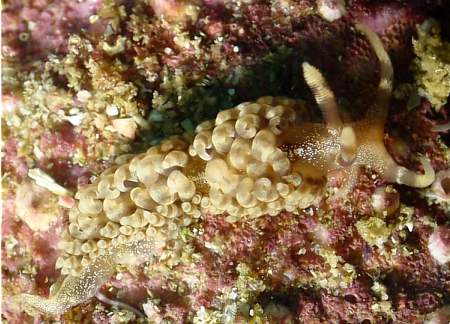
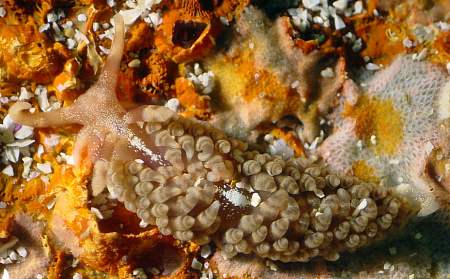
Dear Bill,
Here is Pruvotfolia pselliotes from Dakar. I'm quite sure about this ID, but I'd like you to confirm it. They were found under stones.
I noted a funny behaviour in this species : each time I touched these animals they were bristling their cerata. I assume it is a defensive behaviour ?
Upper Photo:
May 27, 2003
Location: Dakar, Senegal, Eastern Atlantic
Site: Iles Madeleine
Depth: 13m
Size: 15mm
Middle & Lower Photos:
May 31, 2003
Location: Dakar, Senegal, Eastern Atlantic
Site: Iles Madeleine
Depth: 10m
Size: 25mm
Photos: Marina Poddubetskaia - Nembro website
Best wishes,
Marina.
nembro@nembro.info
Poddubetskaia, M., 2003 (Aug 9) Pruvotfolia pselliotes from Senegal [1}. [Message in] Sea Slug Forum. Australian Museum, Sydney. Available from http://www.seaslugforum.net/find/10271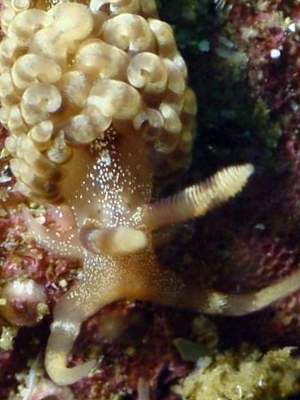
Dear Marina
I agree that these are most likely to be Pruvotfolia pselliotes. The colour, fine numerous lamellae on the rhinophores and curled inner cerata are all characteristic of this species. If this identification is confirmed it is a considerable extension of this species' known geographical range as I know of no record south of the Mediterranean.
However, I have moved the third animal, which you thought was a juvenile Pruvotfolia pselliotes, to a separate message. I am pretty sure it is a juvenile Berghia neapolitana.
As I mention on the Fact Sheet for this species, the inner cerata in each row are much longer than the other cerata, and sit curled up ready to be expanded and aggressively waved around when threatened. As you suggest this seems to be a defensive strategy.
Best wishes,
Bill Rudman
Re: Pruvotfolia pselliotes from Turkey
November 3, 2001
From: Bernard Picton
Sorry, my mistake, Labbe did describe this as Acanthopsole pselliotes, not Facelina. I was relying on Tardy's paper, he must have relied on Pruvot-Fol 1954, who lists it as Facelina. (Acanthopsole is considered a junior synonym of Facelina, introduced by Trinchese in 1874 for Acanthopsole rubrovittata (Costa, 1866, as Eolis)). Now of course if someone decides that rubrovittata and auriculata (coronata) (type species of genus Facelina) don't belong in the same genus then Acanthopsole could be resurrected!. What tangled webs we weave because we mix nomenclature and phylogeny!
I didn't spot Luis Tocino's record as it wasn't linked to Erwin's list.
Bernard
bernard.picton.um@nics.gov.uk
Picton, B.E., 2001 (Nov 3) Re: Pruvotfolia pselliotes from Turkey. [Message in] Sea Slug Forum. Australian Museum, Sydney. Available from http://www.seaslugforum.net/find/5612Re: Pruvotfolia pselliotes from Turkey
November 2, 2001
From: Erwin Köhler
Dear Bill,
If the ID of Luis Sánchez Tocino is o.k. there are records of Pruvotfolia pseliiotes from Granada - I still believe this is the Mediterranean coast: http://www.ugr.es/~lstocino/p_pselliotes.htm
I thought it was described as Acanthopsole pselliotes, but I have no access to the original text - though I tried very hard.
Erwin
Erwin@medslugs.de
Köhler, E., 2001 (Nov 2) Re: Pruvotfolia pselliotes from Turkey. [Message in] Sea Slug Forum. Australian Museum, Sydney. Available from http://www.seaslugforum.net/find/5606Dear Erwin,
Thanks for the reference to the Mediterranean record in your checklist which was queried in Bernard's message. Even from Australia, I agree that the Granada coast is in the Mediterranean - if just. Checklists like yours are an extremely valuable first step, but if they have no references to the source of the record, or an accompanying photo, then they can't really be used as 'evidence'. Building up scientific knowledge is a slow painstaking process and we need to be able to follow the trail of evidence back to the original 'fact' or observation. If I published a list of opisthobranchs from southeastern Australia, I wouldn't expect anyone to use it as 'fact' unless it included photos, specimen data, and a full bibliography. Even the most diligent workers can make mistakes so we must be able to go back to the original information. I guess the Gastropteron rubrum v. G. meckeli problem is a case in point. Assumptions were made very early on and then many later workers just accepted that G. meckeli was introduced by Kosse in 1813 without checking the original source.
It can be a painfully slow process, but it works. This is not a criticism of your checklist which is a valuable resource. In a perfect world your list would have references, there would be 48 hours in a day and we would all have a team of assistants to help us with our websites.
Best wishes,
Bill Rudman
Re: Pruvotfolia
November 1, 2001
From: Bernard Picton
Hi Bill,
Here is some text for the Pruvotfolia pselliotes page: .
Pruvotfolia pselliotes was initially described under the name of Facelina pselliotes. It has a very distinctive arrangement of modified cerata associated with the reproductive apparatus which Tardy felt justified the creation of a new genus for it in 1969. Its body is translucent tinted with brown on the oral tentacles, rhinophores and back. There are numerous opaque white spots on the body. The oral tentacles are long, stout at the base, tapering to fine points. They have yellow-ochre pigment at the tips and in a band midway along them. The rhinophores have similar pigmentation and have about thirty fine lamellae. The cerata have two yellow-ochre bands and a yellow-ochre tip. They are numerous and range in size from very small ones at the sides to long muscular ones in the centre of the back which are normally coiled inwards but can be flexed vigorously when the animal is disturbed. These long ones can easily be shed (autotomised) and regrow quite quickly. Other species with similar cerata are Caloria elegans and Moridilla brocki.
Tardy found numerous animals intertidally at a few sites on the French Atlantic coast where they were feeding on a variety of hydroids. The spawn coil as laid in his aquarium was a fine spiral.
Cheers,
Bernard.
bernard.picton.um@nics.gov.uk
Picton, B.E., 2001 (Nov 1) Re: Pruvotfolia. [Message in] Sea Slug Forum. Australian Museum, Sydney. Available from http://www.seaslugforum.net/find/5602Thanks Bernard,
I have added your contribution to the top of the page. Similar contributions by other participants are always welcome.
Best wishes,
Bill Rudman
Favorinus sp.? from Turkey
October 30, 2001
From: Baki Yokes
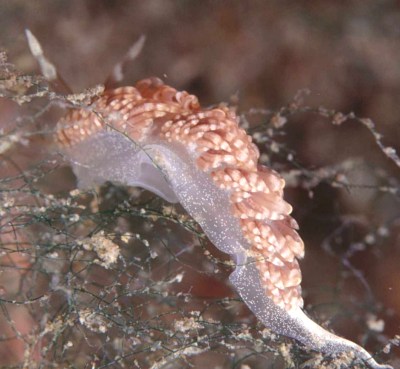

Dear Bill,
Here is another species which saw for the first time, in the sea of Marmara, Istanbul. The colour and shape of the rhinophores suggest a Favorinus species. They are found below 25m of depth and on rock surfaces. Can you identify it? Thank you in advance.
UPPER PHOTO: Istanbul, Turkey
Divesite: Yassiada
Depth: 30m
Size: 5cm
Date: 30 September 2001
Photo: Hasan Yokes: hyokes@turk.net
LOWER PHOTO: Istanbul, Turkey
Divesite: Yassiada
Depth: 27m
Size: 5cm
Date: 30 September 2001
Photo: By Baki Yokes
Best wishes
Baki
bakiyokes@turk.net
Yokes, B., 2001 (Oct 30) Favorinus sp.? from Turkey. [Message in] Sea Slug Forum. Australian Museum, Sydney. Available from http://www.seaslugforum.net/find/5471Dear Baki,
Certainly the swelling on the rhinophores which can be seen in the upper photo is suggestive of a species of Favorinus but the arrangement of the cerata in closely packed rows, and the coiled inner cerata [see inset] are more typical of one of the hydroid feeding genera like Phidiana.
I asked Bernard Picton for his opinion on your photos and he has identified it as Pruvotfolia pselliotes (Labbe, 1923), an identification with which I totally agree. As he says in his separate message, this is probably the first Mediterranean record of this animal which was known previously only from the Atlantic coast of France. This is another very interesting find.
Best wishes,
Bill Rudman
Pruvotfolia pselliotes from Turkey
October 30, 2001
From: Bernard Picton
Hi Bill,
Baki's photo isn't of an animal I've seen, but I'm sure that it is Pruvotfolia pselliotes (Labbe, 1923). I've just looked at Tardy's paper of 1969 and there are black and white photos as well as all the detail you could ask for. In creating the new genus he describes the odd modified cerata associated with the genital opening which are the basis of the new genus. Terry Gosliner synonymises Facelina faurei Barnard, 1927 from South Africa in his book, Nudibranchs of southern Africa, but it looks significantly different from these pictures - in particular it doesn't have the same markings on the oral tentacles (and you know my dislike of 'the cosmopolitan species concept' as I heard it called at a recent taxonomic workshop). I can't see the rhinophore lamellae in Baki's picture but everything else seems to fit well. I'll have a go at writing a page for you if you like.
I see Erwin Koehler includes this species in his list of Mediterranean species, though Tardy says it has only been found on the Atlantic coast of France. Gary MacDonald has the only other citation as Ortea & Urgorri, but I guess this would be the Galicia coast of Spain (also Atlantic) so I don't think it has been reported from inside the Mediterranean.
References:
• TARDY, J. P. 1969. Un nouveau genre de nudibranche méconnu des côtes Atlantique et de la Manche: Pruvotfolia (nov. g.) pselliotes, (Labbe) 1923. Vie et Milieu (A), Biologie Marine, 20(2): 327-346, 6 pls.
• ORTEA, J. A., & V. URGORRI. 1981a. Runcina ferruginea Kress 1977, et Pruvotfolia pselliotes (Labbe, 1923) dans les eaux Ibériques. Vie et Milieu, 31(2): 149-151.
Bernard
bernard.picton.um@nics.gov.uk
Picton, B.E. , 2001 (Oct 30) Pruvotfolia pselliotes from Turkey. [Message in] Sea Slug Forum. Australian Museum, Sydney. Available from http://www.seaslugforum.net/find/5591Thanks Bernard,
It is indeed another interesting find and I accept your offer to prepare a 'page' on this species without hesitation.
Best wishes,
Bill Rudman
